Round The World and other travels
A frequent flyer's collection of trip diaries
This is: Northern Spain 2015
Sunny Barcelona
After a very pleasant in-house breakfast at the NH Ciudad de Zaragoza, we set off on the three-hour drive to our final destination, Barcelona. We had no trouble finding our way to Highway E-90 and followed it all the way to the outskirts of our destination, racking up a toll of just under 30 euros in the process. Having said that, the road was in near-flawless condition and it wasn't especially busy; in other words, it was a pleasure to drive. Taking the correct exit for the city's Avenida Diagonal, it was then a reasonably straightforward matter to drop our bags off at the Hilton and return the car to the nearest Sixt depot at Sants Station, subsequently returning to the hotel by metro.
 Barcelona
is the capital of the autonomous community of Catalonia (Spanish:
Cataluña; Catalan:
Catalunya).
In a similar manner to the Basque Country, Catalonia's statutes of
autonomy identify it as a constituent nation of the Kingdom of
Spain, rather than a Spanish region, and a further similarity is
that there is a long-standing political movement in Catalonia aiming
to achieve independence as a sovereign state within Europe. The area also
has its own Catalan language, and Catalonians refer to standard
Spanish as 'Castilian'. (Catalunya means 'land of
castles', so that perhaps a little ironically, the name may share a
common root with 'Castile'.) Based purely on my own observations,
most internet addresses are of the form '.cat', rather than '.es'.
Barcelona
is the capital of the autonomous community of Catalonia (Spanish:
Cataluña; Catalan:
Catalunya).
In a similar manner to the Basque Country, Catalonia's statutes of
autonomy identify it as a constituent nation of the Kingdom of
Spain, rather than a Spanish region, and a further similarity is
that there is a long-standing political movement in Catalonia aiming
to achieve independence as a sovereign state within Europe. The area also
has its own Catalan language, and Catalonians refer to standard
Spanish as 'Castilian'. (Catalunya means 'land of
castles', so that perhaps a little ironically, the name may share a
common root with 'Castile'.) Based purely on my own observations,
most internet addresses are of the form '.cat', rather than '.es'.
With a population of 1.6 million in the city itself and over 5 million in the wider metropolitan area, Barcelona is a major urban centre by any standards and is widely regarded as one of the 'must-see' cities of Europe. This was my third visit over a period of nearly twenty years.
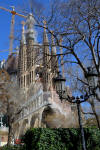 |
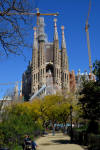 |
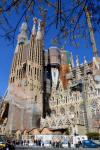 |
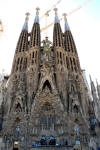 |
| ABOVE: Sagrada Família, the unfinished masterpiece of Antoni Gaudí | |||
After briefly settling into our latest accommodation, we set out on the metro for the city's most iconic sight, the Sagrada Família (Holy Family) church. Designed by Catalan architect Antoni Gaudí with construction getting underway in 1882, this truly unique building remains unfinished. Despite this, it has already been made a UNESCO World Heritage Site and was raised to the rank of Basilica by Pope Benedict XVI. A new push is currently being made to attempt completion by 2026 (the centenary of the architect's death), a feat which will involve a substantial increase in the overall height of the current structure, as the central spire finally takes shape.
Faced by daunting queues for admission upon our arrival, we grabbed a bite to eat in a small eatery on Carrer de Mallorca. As the lines were just as bad when we had finished, we decided to settle for a walk around the exterior on this occasion. There were too many other parts of Barcelona to be visited in a relatively short time!
 |
 |
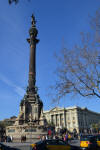 |
 |
 |
|
| At the foot of La Rambla, at the waterfront: an impressive Army HQ building, the Maritime Museum and the Columbus Monument | ||
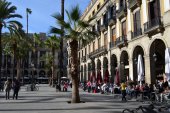 |
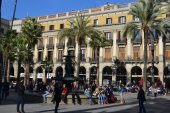 |
| The perfect spot for a refreshment - Royal Square |
Relocating to busy Plaça de Catalunya and then strolling down the well known (and in my view, considerably overrated) street La Rambla brought us to the waterfront area, where buildings such as the Army Headquarters and the Maritime Museum, and an impressive column in memory of Christopher Columbus, provided plenty of interest. Once we had taken it all in, we decided to head into the heart of the Gothic Quarter, Barcelona's 'old town' district. We hadn't got very far with this venture when passing through the attractive and highly photogenic Plaça Reial triggered the idea of stopping for a late-afternoon refreshment of the liquid variety.
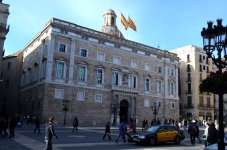 |
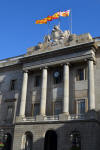 |
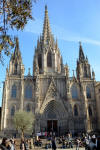 |
| From left to right: Palace of the Government of Catalonia, Barcelona City Hall and Barcelona Cathedral | ||
Pressing on into the Barri Gòtic took us through a rabbit's warren of well shaded streets, lanes and alleys. We eventually emerged into Plaça de Sant Jaume (St James's Square), where the respective seats of the Catalonia government and Barcelona city council faced off to each other across the open space. From there, it was a short walk to Holy Cross Cathedral, the facade of which had been dramatically cleaned up since I had first seen it in the late 1990s, when it was an unattractive and grimy shade of black.
Continuing north-eastwards across the Via Laietana, we came to the Mercat Santa Caterina, one of Barcelona's bustling retail food markets. The building's family resemblance to the Scottish Parliament in Edinburgh was no coincidence; both are the work of the late Catalan architect Enric Miralles, in partnership with Italian-born Benedetta Tagliabue.
 |
 |
 |
 |
 |
 |
Finally, following a few more minutes of walking through narrow streets, we emerged into the open space of the Passeig de Lluís Companys, where people were enjoying the sunshine, seemingly under the watchful gaze of the Palace of Justice and the Arc de Triomf. The latter was built for the Barcelona World Fair in 1888.
 |
 |
 |
 |
 |
 |
From there, it was a relatively easy matter to
make our way back to base on the city's efficient metro, with just
one change from the Red Line to the Green Line. After a short rest,
we sampled the Hilton's executive lounge for a while in our quest
for evening drinks and sustenance, but neither of us felt that it
was particularly inspiring. Relocation to the hotel's beautiful
lobby bar Vibe, on the other hand, turned out to be a
thoroughly sound move.
![]()